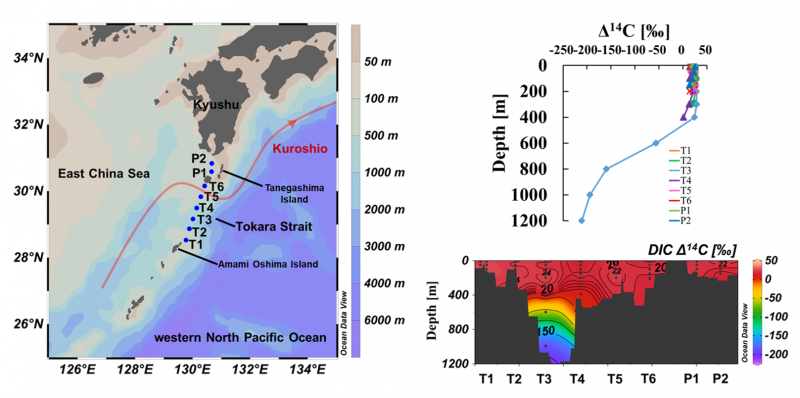
First dataset of dissolved inorganic radiocarbon in the Tokara Strait
ABSTRACT

Radiocarbon (14C) has been widely used to understand the ages in archeology and paleo-environmental sciences. In marine environments, the dissolved inorganic radiocarbon (expressed as DIC Δ14C) of seawater has been used as a reliable tracer in the research of carbon cycling and studies in global to regional water mixing. Here, we present the first high-resolution dataset of DIC Δ14C values in the Tokara Strait collected at eight stations during a cruise on the Research Vessel (R/V) Hakuho-Maru in March 2022. The DIC Δ14C ranges from –211‰ to 28‰ in the upper 1200 m depth of the Tokara Strait. High and modern values (bomb 14C; DIC Δ14C ≥ 0‰) were observed above ~400 m depth at station T3 and above ~200 m depth at other stations. These are indicative of the influence of anthropogenic carbon from above-ground nuclear bomb tests conducted in the Pacific Ocean during the 1940s to 1960s. The dataset also includes hydrographic information (temperature, salinity, and density), all of which may help interpret the DIC Δ14C variations in the Tokara Strait. These datasets are expected to improve our understanding of water mixing processes and the carbon cycle in the Tokara Strait, which has important implications for understanding climate variability.
KEYWORDS
Keywords: radiocarbon, dissolved inorganic carbon, Kuroshio, carbon cycle, Tokara StraitSupplementary Materials(file)
https://www.jstage.jst.go.jp/article/geochemj/0/0/57_GJ23018/_supplement/_download/57_GJ23018_1.pdf
- Published : 2023
- Released on J-STAGE : 2023/12/23
- Received : 2023/10/24
- Accepted : 2023/11/19
- DOI : https://doi.org/10.2343/geochemj.GJ23018
- J-STAGE URL : https://doi.org/10.2343/geochemj.GJ23018
- J-Online ISSN: 1880-5973
- Print ISSN : 0016-7002
- ISSN-L : 0016-7002
All Issues
- Vol.59, 2025
- Vol.58, 2024
- Vol.57, 2023
- Vol.56, 2022
- Vol.55, 2021
- Vol.54, 2020
- Vol.53, 2019
- Vol.52, 2018
- Vol.51, 2017
- Vol.50, 2016
- Vol.49, 2015
- Vol.48, 2014
- Vol.47, 2013
- Vol.46, 2012
- Vol.45, 2011
- Vol.44, 2010
- Vol.43, 2009
- Vol.42, 2008
- Vol.41, 2007
- Vol.40, 2006
- Vol.39, 2005
- Vol.38, 2004
- Vol.37, 2003
- Vol.36, 2002
- Vol.35, 2001
- Vol.34, 2000
- Vol.33, 1999
- Vol.32, 1998
- Vol.31, 1997
- Vol.30, 1996
- Vol.29, 1995
- Vol.28, 1994
- Vol.27, 1993
- Vol.26, 1992
- Vol.25, 1991
- Vol.24, 1990
- Vol.23, 1989
- Vol.22, 1988
- Vol.21, 1987
- Vol.20, 1986
- Vol.19, 1985-1986
- Vol.18, 1984
- Vol.17, 1983
- Vol.16, 1982
- Vol.15, 1981
- Vol.14, 1980
- Vol.13, 1979
- Vol.12, 1978
- Vol.11, 1977
- Vol.10, 1976
- Vol.9, 1975
- Vol.8, 1974
- Vol.7, 1973
- Vol.6, 1972-1973
- Vol.5, 1971
- Vol.4, 1970-1971
- Vol.3, 1969-1970
- Vol.2, 1968
- Vol.1, 1966-1967




